Government Schools in Tonk: Some Observations Based on My Visit
By Muthulakshmi RTS
Introduction
Education is an inevitable, long-term, persistent activity to hone human skills and competencies, which benefit society. Our country’s education system is the largest in the world, where over 15 lakh schools impart education to more than 26.5 crore students (Table 1) through government, government-aided and private institutions. In the last decade, the number of students enrolled in private schools has increased due to a general belief that education is better in these institutions. Financial affordability and accessibility have ensured that more than 70 percent of the rural sector with various socio-economically weaker sections have access to formal education through government and government-aided schools. These schools are lifelines of our rural education system since schemes like mid-day meals and the distribution of free textbooks and uniforms further reduce the financial burden on families (Figures 1-2).
Table 1. Total number of schools and student enrolment in India for the year 2020-21
| Type of Management | Total # of Schools | Total # of Students |
| Government | 10,32,049 | 13,49,04,560 |
| Govt aided | 84,295 | 2,68,45,527 |
| Private unaided | 3,40,753 | 9,51,57,082 |
| Others | 52039 | 75,42,818 |
| Total | 15,09,136 | 26,44,49,987 |
Rajasthan is the largest state in India by area and placed 7th by population. Government schools are the only hope for more than 75 percent of the population concentrated in rural areas and deserts in this state.1 About 70 percent of the schools in Rajasthan are government-run; there is no concept of government-aided schools. The state has remained one of the most backward states in literacy since its formation and the main reason for this is its low rate of literacy among women – the lowest compared to the other states in India. The current literacy rate in Rajasthan stands at an estimated 69.7 percent, while the women’s estimated literacy rate is 57.6 percent.2 Rajasthan also has the widest gender literacy divide in India – a 23 percent literacy rate difference between men and women. A few major reasons for the low rate of women’s literacy are its conservative culture, patriarchal family structure, weaker economic status, ineffective policies, and poor accessibility to schools in desert areas due to lower population densities.3 However, the school-student database indicates that currently, gender diversity at the school level is narrow with a growing number of female enrolments4 (Fig 1). More boys than girls are enrolled in private schools when compared to other states in India, whereas the strength of boys and girls in government schools is almost equal (Fig 2).
Figure 1. Boy vs. girl students in Rajasthan
Figure 2. Boy vs. girl students enrolled in different types of schools in Rajasthan
My visit to a few such government schools was part of the ‘Government Schooling in India’ course conducted by Azim Premji University for undergraduate students in October 2022. We visited three schools, an Anganwadi Centre and associated local communities within a 25 km radius of Tonk to get a first-hand experience of the government school ecosystem. My learnings and understanding of the state’s education system through the lens of sociological and child development perspectives are reported in this paper. Some of the aspects considered are:
- General literacy among students
- Frameworks and standards followed by government schools in Rajasthan
- An actual school day and how it looks like for a student
- Students’ backgrounds and their influence on their study interests
- The spirit of competition and aspirations among students
Upper Primary School
We observed an upper primary school (grades I-VIII) and two senior secondary schools (grades I-XII) for two days each. These schools, like all other Rajasthan government schools, follow a 6-day system from 7.30 am till 1 pm during summer. All these schools follow NCERT textbooks with 35 minute-period allotted for each subject. Schools start with the morning assembly every day. Mid-day meal is served to all the students from 10.15 -11.00 am during summer. Teacher-student interactions and classroom teachings happen in the Marwari language though the official medium of instruction is Hindi. Every working Saturday is a No-bag Day.5 Girls in all government schools have regular self-defence classes.
Pupil-Teacher Ratio and enrolment
The Upper Primary School has more than 250 students and 6 teachers (including the acting principal). The student-teacher ratio is 42:1 as against the 25:1 recommended for such schools by the National Education Policy 2020 (NEP 2020). The school comes under the purview of the Directorate of Elementary Education. Girls constitute 70 percent of the total number of students in this school and the data is consistent with the government data of girls versus boys studying in Rajasthan (Fig 2). Only six classrooms are available for eight grades, so students of different grades are taught together in a single classroom. Students of grades I and II are always taught together in a single classroom, which is okay from the perspective of their learning but having grade VI and VIII students together in a similar vertical single classroom set-up may lead to learning disturbances and distractions during the classes.
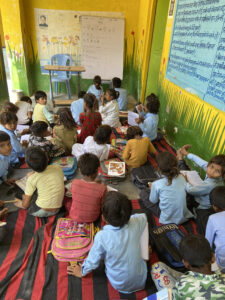 Teachers
Teachers
Two full-time teachers teaching in the school are from the persons with disability (PWD) category and there is a Special Educator for children with special needs (CWSN). All the teachers are regular at school, and they are inside the classes most of the time. Very few teachers use activity-based teaching methods in their classes. They regularly attend in-service training conducted by District Institutes for Education and Training (DIET). Out of all the teachers, four are primary teachers. No subject teachers are available for upper primary mathematics, science, and social sciences and the Special Educator teaches these three subjects as a personal initiative. Teachers, while they are teaching a grade, give work to other grades. They act as guides to the students and work with them with care and affection; they treat the mid-day meal staff with respect. The existence of bureaucratisation among the teachers was quite visible, matching Weber’s view of stratification.6 Our experience indicated to us that the social structure of the school is complex.
No discrimination
Teaching is one of the most respected professions in the region. Students tend to touch the feet of the teachers as a gesture of respect despite the caste/religious differences between teachers and students. Is this a dispositional knowledge they have acquired as part of embodied and institutionalised cultural capital?7 I did not notice any existence of caste discrimination on the school premises, though students belong to different castes, like Jat, Berwa, and Meena, as well as religions. All the students are considered equal and so there is no fear in them in coming to school. It may not, therefore, be wrong to say that the school acts as social capital and imparts the concept of ‘universalism’ as argued by the well-known functionalist Dreeben.8
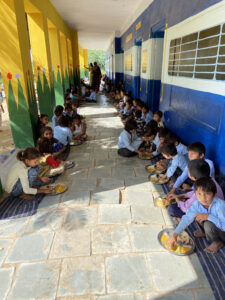
Mid-day-meals
All the students are involved by turns in the serving of the mid-day meals, which consist of at least two rotis and a bowl of dal. This nutrition is essential for the brain development of children. Many students mentioned that they take meals only twice a day, especially boys who tend to play after school and reach home late. This habit is not due to their economic conditions; most of them are from socially and economically sustainable backgrounds. Teachers corroborated this fact.
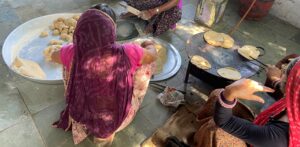 Learning levels
Learning levels
Grade I and II students could read the alphabet. Most grade III and IV students were able to read and write in Hindi. Fifty percent of the students in each grade were able to perform essential arithmetic functions, like addition, subtraction, and multiplication. The much-needed cognitive development, the baseline of a formal school system, seems to exist in this school. English reading skills have not been introduced even in grades III and IV, though the students knew the English alphabet. I also noticed that the students were solving the workbook modules developed by the state Department of Education. These modules were developed for coping with learning loss due to COVID-19 under the scheme Rajasthan Ke Shiksha Me Badhte Kadam.
Students’ positive attitudes
It was surprising to see how grade III-IV students have developed positive social emotions, evident from how they took responsibility for the smooth functioning of the class conducted by a teacher with visual impairment. This development of innovativeness in this age group seems to have happened one stage in advance from those suggested in Erik Erikson’s Stages of Psychosocial Development.9 Grade VIII students, the oldest in the school, take the responsibility of teaching assistants by supervising teacherless classes, maintaining discipline during mid-day meals, and so on due to the lack of teachers. Is this a positive way this school prepares these students to be a part of the larger units of society – families, workspaces, etc?
Culture and context
All students are natives of the same neighbourhood with a farming background and a male-dominant culture. Socio-ecological environment for most of the children is more or less the same and stable. Boys and girls get enough time to play around in addition to performing household/farm chores. Boys have complete freedom to choose what they want to do in their lives. However, they do not have the necessary means to realise their potential and skills. They manage to develop a strong influence in their neighbourhood, always looking for small jobs and quick money after completing grades X and XII. Every boy wants to join the Indian military service, whereas girls aim to become policewomen or teachers. Is this due to the glorification of these careers or do these students think these career options as being powerful? Actually, they do not seem to be aware of other jobs or social opportunities, as no one from their region has taken up any other profession. Is this called negative freedom in the philosophy of education? Are their thoughts being overshadowed by the context of their living? May or may not be. As long as these students enjoy their freedom to choose their careers or better the lives they are leading right now, I feel it is still part of the formative freedom.10
Good practices
The acting principal of this school chooses one student, who is the tidiest, daily during the school assembly as ‘Aaj ka Gulab (Today’s Rose)’. I felt this could be an innovative way of ensuring that students come to school neat and tidy. The principal has also shared a unique plan, wherein people can contribute a rupee per day as a donation for the development of the school premises. This initiative has become successful, and they could collect over one lakh rupees to improve the aesthetics of the school. This participatory action creates a sense of ownership and pride among all concerned. Researchers strongly suggest that the holistic development of a child is greatly affected by the school surroundings and the facilities provided to them at school. Students take turns cleaning the school premises and watering the plants, as there is no provision for a cleaner or watchman for this school. The school is struggling with funds to provide water facilities for the toilets. I could see only one computer available for the whole school.
Senior Secondary Schools
We also visited a senior secondary school (grades I-XII) with more than 140 students and a pupil-teacher ratio (PTR) of 1:10 – very different from the upper primary school we visited earlier which is just 10 km away. The premises of this school are spacious and relatively clean in the front. There was a pool of water in the playground behind the school due to the rain. The school has more classrooms than the total number of classes. So, a few classrooms are unutilised. 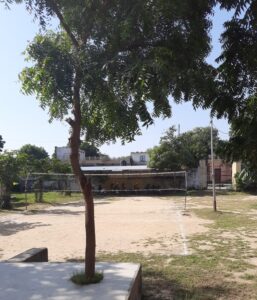
The school also had an audio-visual room with a big LCD screen and four computers. Mid-day meals are provided to all the students up to grade VIII. Both the senior secondary schools (we visited the second one to take a look at the girls’ self-defence classes) had a sports area and a physical education instructor. Students seem to participate regularly in sports events conducted by the government.
Enrolment
There are only 21 students in grades I-V. Most parents prefer private schools over government schools for primary students in this area. Ninety percent of the students studying in grades VI-XII are girls. There are no boys in grade XI. Some girls moved to government schools from private schools during the COVID-19 pandemic in grades IX and above because many parents, financially impacted by the pandemic, found it difficult to pay the high fee in private schools. Some students also mentioned that they joined government schools during the pandemic when government school teachers were sharing study materials with students timely. It was clear that private schools could not cope with online mode during the pandemic.11
The school has girls from all communities. There is no science stream, so boys do not prefer this school in grades XI and XII and since parents want their sons to do higher studies at any cost, they send them to nearby private schools. The students of this area have a stable neighbourhood and lifestyle. Very few families in this community migrate to other states for work, such as during the marriage season, especially as part of music bands.
Teaching-learning
Teachers in the school have good content knowledge of subjects. We could not spend enough time evaluating students’ reading and writing skills. From what we observed in the classroom discussions, girls seemed to have a better conceptual understanding than boys. The reason behind this could be their lack of interest in studies as most of the boys who attend government schools are those who have been denied admission to private schools for various reasons. Boys are given remedial practice in subjects during the time the girls go for their self-defence sessions.
An average student in grade VIII could solve square root problems, which is a sign that they are taught mathematics well. Likewise, most of the students answered the questions involving the transformation of matter in science. One of the observations worth mentioning here is that the teacher completed more than 40 percent of a science chapter in a 40-min period. Teaching one topic a day may improve conceptual understanding in the class.
My observations on assessments show that these are considered mere procedures here. One startling discovery regarding assessments in both senior secondary schools that we visited (the second only to see the girls’ self-defence session) is that the assessments are that students are helped by teachers in answering the questions. There seemed to be no concept of considering assessments as diagnostic tools to check whether the concepts in post-COVID learning modules are understood by students properly.
Students’ aspirations
Boys here look forward to joining the military service and girls, the police service, though they have a better awareness of other professions compared to the students at the upper primary school.
Government initiatives
We also visited the office of the Assistant Chief Block Education Officer (ACBEO) and were impressed to learn about the various schemes being implemented by the Rajasthan government to improve the literacy and standard of living of the people, such as Rajasthan ke Shiksha me Badhte Kadam12 Udaan13 and No-bag Day,14 another unique initiative for government school students. We also learnt about the organisational structure and the technical advancements in the Department of Elementary Education and how the government is initiating efforts to ensure that teachers are not absent from work and execute their duties without fail. This made me realise how true the words of K Kumar15 continue to remain valid even after a decade:
‘The official routines and rules that govern the lives and careers of teachers to this day almost prohibit independent thinking and ingenuity. Even in purely academic matters as shaping the curriculum and selecting pedagogical material, obsolete procedures and expectations continue to hold sway even as new ideas are advocated as being more preferable.’
Community and Context
We visited the nearby communities to find out their perspectives on government schooling. Some of the views of the parents whose children are studying in government schools were as follows:
- The standard of teachers appointed by the government is very good, but they become casual once they join as government employees.
- Sometimes, teachers are not appointed for certain subjects, or some teachers are not regular to school because of which students’ learning suffers. This is also the main concern which leads to boys being enrolled in private schools.
- Private schools are an investment for boys’ education, whereas girls must be married off once they reach 18 years of age.
- It is perfectly all right to send girls to government schools.
- Private schools may not have proper buildings or qualified teachers but teachers are always present in class, whereas government school teachers do not come to school regularly.
- More teaching takes place in private schools as there are no extracurricular activities, and they give homework regularly. Learning, therefore, becomes a continuous process. In government schools, this is uncertain – some days teaching takes place very well and on other days, there is no teaching at all.
- Government school teachers treat students differently based on their caste and class.
- Teachers should not be posted in government schools in their native villages. They take some classes and end up looking after their farms and personal work the rest of the time.
- Child marriages lead to imprisonment so marriages can be fixed in childhood and the legal marriage can take place later as soon as the bride and groom reach the legal age of marriage.
- It is up to the groom to decide whether his wife can continue further studies after marriage.
This region has a caste-based, patriarchal society. Women tend to hide their faces with dupattas as soon as they see a man coming. After a prolonged conversation with them, we found out that there is a dress code for women depending on the caste – women from Brahmin or high-caste families only wear sarees, whereas women from the lower caste wear ghagra-choli. This was the first time I encountered such a tradition existing in India. I also came to know of a teacher who belongs to the lower caste but is given importance in school just because his brother is the Sarpanch of the village. This shows the existence of cultural assimilation as argued by the functionalist education reformers. There is also this class formation of ‘teachers’ as theorised by Weber on class and status. Interestingly, this same teacher does not allow people from his own (lower) caste to enter his house.16
Boys being sent to private schools for English medium education as an investment perfectly fits with the Human Capital Theory, in which education is viewed as a means to more productivity with the development of skills and thus, better employability. One noteworthy observation is that the private school running in this village charges more than Rs. 7000/- as annual fees. The school owner also helps many students get enrolled under the RTE Act. More girls going to government schools can be attributed to the fact that the fee structure may not be affordable for most of the parents in that area, instead, they might want to save the same for their marriages. Culturally, they follow endogamy. This community does not like to send their daughters to far away schools as there is a fear of girls falling in love with people from other communities. It was interesting to learn from the community that girls take admission to colleges but do not go to colleges regularly – their father or brother accompanies them to college once a month to collect materials and fill out the attendance sheet.
Couples who have an inter-caste marriage, are ostracised. Such couples live in faraway places or other states. This is when Rajasthan even has an inter-caste marriage scheme17to encourage such marriages and promote harmony among social groups. It is interesting to note that there is only one inter-caste couple registered till the year 2020-21 in the three villages that we visited.18 Parents are willing to spend more money on the marriage of girls and on other occasions in the groom’s family in the name of societal culture. These restrictive circumstances come in the way of the aspirations of girls and stop them from achieving their potential through the formal education system.
However, children in these areas have ample opportunities of being physically active and occupationally competent. Boys learn farming by observing their parents, however, they are not forced into this occupation. The girl children with whom I had a chance to talk to, knew crafts, sewing, cooking, etc. I felt that the children were learning productive work with no undue pressure from parents, matching Gandhi’s and Amartya Sen’s views on developing learning and human capabilities.19 20 The children studying in grade XI expressed their strong views against class and caste-based discrimination and their rejection of living the way their parents had. Therefore, it may not be wrong to say that schools do indirectly act as instruments for social integration and solidarity.
Anganwadi Centres
We also visited two Anganwadi Centres. There were 10 children in one and 15 in the other. I felt that children in their pre-operational stage (3-5 years) of cognitive development are taken care of with appropriate nutrition. They are also taught to draw and recite poems with actions informally as suggested in Piaget’s Theory and Stages of Cognitive Development. The children seemed shy on first seeing us but soon became very friendly. I could see them being successful in terms of their third stage of development as theorised by Erik Erikson.
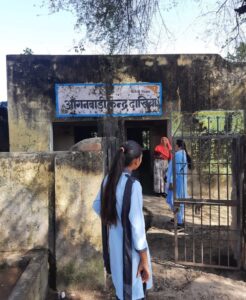
I also learned that sanitary napkins for rural girls are now being distributed through these Anganwadi centres.
Summary
My four days in Rajasthan were valuable, meaningful, and insightful. Students in the government schools I visited were largely first-generation learners from stable economic backgrounds. Many students are regular, well-mannered and intelligent. More than 70 percent of the students enrolled in these schools are girls complying with the government database in Rajasthan. A growing number of male students enrolled in private schools for English medium education is considered an investment for better employment in future, perfectly fitting with the Human Capital Theory. Funds spent on girls for education are considered unnecessary in this patriarchal society.
Teaching is a highly respected profession here. Most teachers are committed to their work ethics and act as guides to their students with love and emotion. I have observed a few teachers using activity-based methods in classes and learned that they also participate in in-service training conducted by the DIET. Teachers consider all students equal inside the school premises, indicating that the schools act as social capitals and impart the concept of ‘universalism’. A few students expressed unhappiness over class and caste-based discrimination existing in their society, instead of just accepting and living the way their parents have done. This could be the result of the schools indirectly acting as instruments for social integration and solidarity.
Complexities in the organisational structures, delays in the funding and teacher recruitments, improper allocation of teaching resources in schools, location of the school and non-commitment of few teachers are some of the drawbacks leading to low enrolment in government schools.
AUTHOR
Muthulakshmi RTS is Faculty, School of Arts and Sciences at Azim Premji University, Bengaluru

